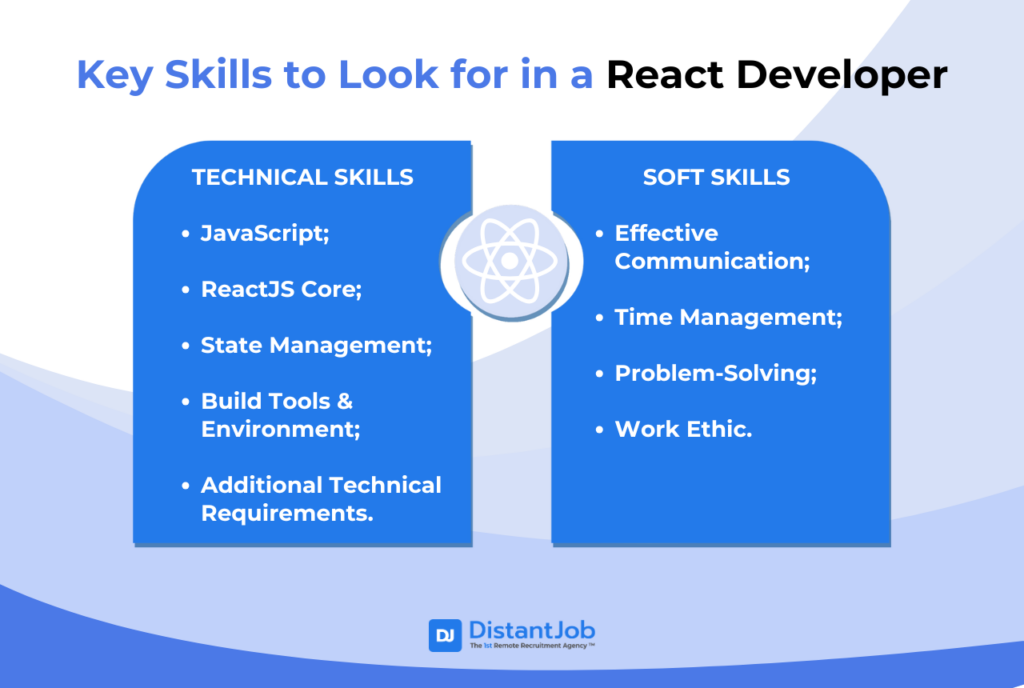Looking to hire React developers from Eastern Europe? With 70% of US companies now embracing remote development teams and Eastern European developers ranking among the top 3 choices for technical talent, you’re on the right track. But while hourly rates might be 30-40% lower than US markets, finding and securing top React talent from this region requires a strategic approach that goes beyond cost savings.
After placing hundreds of React developers from countries like Ukraine, Poland, and Romania with US companies, I can tell you that the landscape has changed dramatically. The best React developers in Eastern Europe aren’t just coders – they’re software engineers with strong computer science foundations who specialize in React and are already employed, so you have to move quickly when you find the right match.
This comprehensive guide will walk you through the exact process of finding, evaluating, and hiring Eastern European React developers, based on real experience placing developers with companies from Y Combinator startups to Fortune 500s. Whether you’re looking to build a new development team or strengthen your existing one, you’ll learn how to navigate time zones, conduct effective technical assessments, and secure top talent before your competitors do. Let’s start with the key skills you should look for.
Key Skills to Look for in a React Developer

When hiring a React developer, ensure the candidate has technical proficiency in JavaScript, HTML, CSS, and modern JavaScript frameworks like React. The potential hire must also possess soft skills, such as strong communication abilities, problem-solving capabilities, and a good work ethic.
Let’s look at some of the most important ones:
Technical Skills
- JavaScript: Deep understanding of ES6+ features, proficiency in asynchronous programming, strong grasp of functional programming concepts, experience with JavaScript testing frameworks
- ReactJS Core: Component lifecycle management, Props & State management, React Hooks, virtual DOM, React Router
- State Management: Redux/Redux toolkit, context API, State debugging tools
- Build Tools & Environment: Webpack, npm/yarn, Create React App, Code optimization
- Additional Technical Requirements: Version control (Git), REST API integration, performance optimization techniques, responsive design principles, cross-browser compatibility expertise, mobile-first development practices, Agile methodology
Soft Skills
- Effective Communication: The candidate should have strong English language proficiency (at least upper-intermediate level). This ensures they can easily collaborate with international teams, express technical concepts clearly, and participate actively in daily standups and project discussions.
- Time Management: Remote work means working independently. Hence, you must ensure potential hires can prioritize tasks effectively and consistently meet project deadlines without requiring constant supervision.
- Problem-Solving: Look out for candidates who demonstrate analytical thinking and can tackle complex technical challenges independently.
- Work Ethic: Successful products result from dedicated developers who take ownership of their work, maintain high coding standards, and show initiative. Ensure your potential hire is reliable, pays attention to details, and demonstrates a strong commitment to continuous learning.
Now that you know the skills to look for, let’s go into the hiring process.
3 Steps to Hire Eastern European ReactJS Developers
Hiring the right Eastern European React developer means high-quality solutions at affordable prices. To do so successfully, outline your requirements, source candidates, and screen and assess them. And finally, hire and onboard the best ones.
Below is a breakdown of the entire process:
1. Step One: Preparation and Planning
Understand their Culture Advantage
Eastern European developers often bring a surprising cultural advantage: direct communication. Unlike some offshore regions where “yes” might mean “maybe,” these developers tend to be refreshingly straightforward. They’ll tell you when something’s not feasible, challenge poor architectural decisions, and propose better solutions. This directness saves countless hours of misunderstandings and prevents costly development mistakes.
Determine Your Budget
In terms of budget, Junior React developers in Eastern Europe typically charge between $55 and $60 per hour. Mid-level developers range from $65-800, and senior developers command $95+ per hour.
Consider adding a 20% buffer to your budget for unexpected costs. This allows you to accommodate rate negotiations, additional features, or potential project extensions. As well, set aside a budget for onboarding, training, and any necessary tools or software licenses. By doing so, you will ensure smooth project execution and better team collaboration.
Pro tip: Look beyond capital cities. Developers in cities like Lviv or Krakow, with similar skill levels, often charge less than their capital city counterparts. This is due to lower living costs.
Consider Time Zone
While most focus on the time difference challenge, it’s actually an opportunity. Your Eastern European team works while your US team sleeps, creating a continuous development cycle. However, here’s the key: establish a 3-4 hour overlap window for critical discussions. Many developers in this region willingly adjust their schedules to maintain this overlap, typically working until 6-7 PM EST.
Once you’ve figured out all these, you can create the job description.
Create a Detailed Job Description
A ReactJS developer job description will have the same features as other job descriptions. This includes roles and responsibilities, required skills and qualifications, preferred experience levels, project details, as well as company culture information, and benefits package.
However, it will also include specific React-related requirements, such as experience with React Hooks, Redux state management, and component lifecycle methods.
When writing the job description, avoid cliches like “rockstar developer.” or “ninja coder.” Instead, focus on concrete requirements, growth opportunities, and what makes your company culture unique. Europeans prefer a more formal and direct communication style. Plus, speaking like that is just cringe-worthy and can deter serious professionals from applying.
In addition, effective job descriptions focus on outcomes rather than just requirements. Instead of saying, “Must have 5 years of React experience,” highlight what you expect them to achieve.
For example, “develop and maintain scalable React applications that serve 100,000+ daily users” or “optimize application performance to reduce load times by 50%.“
Here’s what an impact-focused job description targeting Eastern European React devs looks like:
Position: Senior ReactJS Developer
Location: Remote (Eastern Europe)
About Us:
[Company Name] is a fast-growing SaaS platform helping businesses streamline their operations. With over 100,000 users worldwide, we seek a talented Senior ReactJS Developer to join our distributed team and help scale our frontend architecture.
Impact You’ll Make:
– Lead the development of new features that will serve 100,000+ daily active users
– Optimize application performance to achieve sub-2-second load times
– Mentor junior developers and contribute to our engineering culture
– Architect scalable solutions for complex business problems
Technical Requirements:
– 5+ years of professional experience with ReactJS and modern JavaScript
– Proven track record of building and maintaining large-scale React applications
– Strong expertise in state management (Redux, Context API) and performance optimization
– Experience with modern testing frameworks (Jest, React Testing Library)
– Proficiency in TypeScript and modern build tools
What We Offer:
– Competitive hourly rate of €60-80 based on experience
– Flexible working hours with a 4-hour overlap with CET
– Professional development budget
– Regular team meetups in European tech hubs
– Long-term project stability
Working Hours:
Core hours 10:00-14:00 CET for team collaboration, flexible scheduling for remaining hours
To Apply:
Please submit your CV, GitHub profile, and a brief description of a challenging React project you’ve worked on. Include your preferred working hours and hourly rate expectations.
This format communicates expectations while highlighting the value proposition for potential candidates. The next step is finding the developers.
Step Two: Sourcing Candidates
Forget generic platforms like Indeed, LinkedIn, or Monster. We are not saying these platforms don’t work — they can. However, they’re hit-and-miss for finding top-notch candidates.
Instead, focus on location-specific community platforms. For instance, DOU.ua for Ukrainian developers — it’s their holy grail of tech communities. For Polish developers, No Fluff Jobs and JustJoinIT are the go-to platforms.
A lesser-known but highly effective strategy involves targeting developers who contribute to local React conferences. Events like React Kyiv, Dev.JS Poland, and JSNation have speaker and attendee lists that are gold mines for talent.
For GitHub sourcing, don’t just look at contribution graphs. Focus on developers who maintain React libraries or contribute to local React documentation. These developers are often more engaged with the community and have a deeper understanding of React’s ecosystem.
If you’re using Stack Overflow, target developers using location-specific tags like ‘react-Ukraine’ or ‘react-Poland’ in combination with high reputation scores in React-related answers.
Coding boot camps or tech initiatives are other good sources. Many top React developers in Eastern Europe teach or mentor at these programs. Build relationships with organizations like Mate Academy in Ukraine or Codecool in Poland. These connections can lead to referrals for both junior and senior developers.
Lastly, you can partner with a specialized IT recruitment agency. These agencies usually have a pre-vetted pool of React developers. They can handle the entire hiring process — from sourcing to technical assessment and contract negotiations.
Step Three: Screening Applications
Most employers use an ATS (Applicant Tracking System) to manage and filter applications based on specific keywords and qualifications. For example, you can set up filters for keywords like “ReactJS,” “Redux,” and years of experience to automatically screen candidates who meet your basic requirements.
While this approach streamlines the process, it has a downside—qualified candidates who haven’t optimized their resumes for the set keywords might miss out.
To avoid this, complement automated screening with manual reviews of portfolios and GitHub profiles.
Speaking of GitHub profiles, you need to be careful when reviewing them. Profiles can be misleading if you only look at surface-level metrics like contribution counts or star ratings. Instead, request code samples, review their pull requests, or live projects.
Afterward, shortlist qualified candidates for interviews.
Step Four: Interviewing
Technical Assessment
Skip the typical “reverse binary tree” questions. Instead, I have candidates walk through their most complex React state management solutions or explain their approach to performance optimization. Their ability to articulate architectural decisions tells you more than any algorithm puzzle.
Forget traditional interviews. I always set up paid test projects that mirror real work scenarios. Have them integrate a complex API, handle state management challenges, or optimize a slow-rendering component. That’s how you find the gems.
Language Assessment
Speaking of the English language, don’t rely solely on English certificates. Some developers may have a B2 certification but struggle with real-world technical communication.
Instead, use a three-step language check: a written technical task, an async video response, and a live discussion. The key is to assess their technical English separately from their conversational English.
Cultural Fit and Communication Dynamics
Eastern European developers have different communication styles and work preferences than Westerners.
They value direct communication, and small talk isn’t as common in professional settings. This isn’t a negative — it often leads to more efficient meetings and clearer project outcomes.
Gauge their compatibility by asking scenario-based questions about teamwork, conflict resolution, and remote collaboration. For instance:
“Your product manager changes requirements mid-sprint. Walk me through how you’d handle this.”
“Tell me about a time when you disagreed with a product manager’s technical approach. How did you handle it?”
“How do you typically communicate progress and blockers in a remote team setting?”
Step Five: Hiring and Onboarding
Hiring
Suppose the candidate meets your requirements and passes the assessments. In that case, the next step is to make an offer.
During contract negotiations, be clear about deliverables, payment terms, and IP rights. Include specific mention of code ownership and repository access. This prevents intellectual property disputes and ensures smooth project handovers.
Besides monetary compensation, offer opportunities for professional growth, flexible working arrangements, and clear career paths.
Familiarize yourself with legal requirements in Eastern European countries. This includes understanding local labor laws, tax implications, and contractor regulations.
Once you’ve reached an agreement, finalize the employment. Next, make sure a few things are in place before they get started.
Set up security protocols, including two-factor authentication, VPN access, and secure repository permissions. Create a detailed access document listing all necessary accounts from AWS to Figma. This prevents the common scenario of developers waiting days for various access permissions.
You should also ensure that they have the necessary hardware and equipment to do their job. Provide clear guidelines about hardware requirements and either ship the equipment directly or provide a stipend for purchasing locally.
Onboarding
Don’t just add your new React developer to the Slack channel and hope for the best. Schedule short, focused meet-and-greets with key team members.
Design a detailed first-week schedule, including specific coding tasks. Include a small, achievable feature implementation on day three — this builds confidence and provides immediate value to the project.
Build comprehensive documentation of your codebase, including architectural decisions, coding standards, and deployment procedures. This should be a living document that evolves with your project. Consider using tools like Notion or Confluence for easy updates and accessibility.
Establish clear async communication expectations. Specify which messages require immediate response versus next-day feedback. Create templates for daily updates and blocking issues.
Assign a mentor or buddy from the existing team to help with questions and provide context. This person should be available during the new developer’s working hours and familiar with the project’s technical stack. Schedule regular check-ins during the first month to address any concerns or roadblocks quickly.
Now you Know
As you can already tell, hiring a ReactJS developer in Eastern Europe is a complex process. It requires careful planning, thorough screening, and effective onboarding strategies to ensure success. There is also the part about understanding the labor regulations in each country.
Can you accomplish this alone? Yes! But it is a time-consuming process that prevents you from doing what you’re actually good at — running your business.
That’s where we come in. We are DistantJob, a specialized IT recruitment agency. For over a decade, we’ve been helping businesses like yours hire ReactJS developers in Eastern Europe. And if you’re not happy, you get your money back.
Our experienced recruitment team handles everything from sourcing and screening to contract negotiations and compliance. Contact us today, and let’s discuss your hiring needs.





